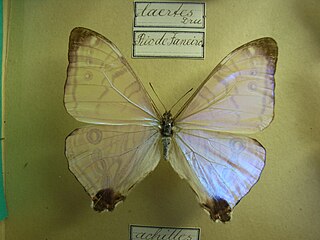
The morpho butterflies comprise many species of Neotropical butterfly under the genus Morpho. This genus includes more than 29 accepted species and 147 accepted subspecies, found mostly in South America, Mexico, and Central America. Morpho wingspans range from 7.5 cm (3.0 in) for M. rhodopteron to 20 cm (7.9 in) for M. hecuba, the imposing sunset morpho. The name morpho, meaning "changed" or "modified", is also an epithet. Blue morphos are severely threatened by the deforestation of tropical forests and habitat fragmentation. Humans provide a direct threat to this spectacular creature because their beauty attracts artists and collectors from all over the globe who wish to capture and display them. Aside from humans, birds like the jacamar and flycatcher are the adult butterfly’s natural predators.

Morpho hecuba, the sunset morpho, is a Neotropical butterfly and the largest species in the genus Morpho. Its wingspan can reach 20 centimetres (7.9 in), but is usually from 13–15 centimetres (5.1–5.9 in). "M. hecuba is the largest known Morpho and one may also call it the most interesting, on account of its habits, its susceptibility to climatic influences and its tendency to develop polychromatic forms in both sexes."

Apatura ilia, the lesser purple emperor, is a species of butterfly native to most of Europe and east across the Palearctic. It is named for its similarity to the purple emperor butterfly.

Morpho polyphemus, the white morpho or Polyphemus white morpho, is a white butterfly of Mexico and Central America, ranging as far south as Costa Rica. As suggested by its name, this is one of the relatively few Morphos that is white rather than blue. Some authorities include M. luna, which is also white, as a subspecies of M. polyphemus.

Iraota rochana, the scarce silverstreak, is a species of lycaenid or blue butterfly with several subspecies found in Manipur, Myanmar, Java, Borneo, Sumatra, Malaya, Langkawi, Thailand, Singapore, Sulawesi and the Philippines. The species was first described by Thomas Horsfield in 1829.

Morpho deidamia, the Deidamia morpho, is a Neotropical butterfly. It is found in Panama, Nicaragua, Costa Rica, Suriname, Bolivia, Venezuela, Colombia, Peru, Ecuador, and Brazil. It is a species group, which may be, or may not be several species. Many subspecies have been described.

Morpho aega, the Aega morpho, is a Neotropical butterfly found in Paraguay, Argentina and Brazil.

Morpho aurora, the Aurora morpho, is a Neotropical butterfly found in Bolivia and Peru.

Morpho portis is a Neotropical butterfly. It is found in Brazil, Uruguay, Venezuela, Colombia, Peru, and Paraguay. Several subspecies and many forms have been described. The larvae feed on Gramineae.

Morpho rhetenor, the Rhetenor blue morpho, is a Neotropical butterfly of the family Nymphalidae. It is found in Suriname, French Guiana, Brazil, Peru, Ecuador, Colombia, and Venezuela.

Morpho richardus, or Richard's morpho, is a Neotropical butterfly found only in Minas Gerais, Brazil.

Morpho anaxibia, the Anaxibia morpho, is a species of Neotropical butterfly endemic to Brazil.

Morpho hercules, the Hercules morpho, is a Neotropical butterfly found in Brazil and Paraguay.

Pseudacraea lucretia, the false diadem or false chief, is a butterfly of the family Nymphalidae. It is found in Africa.

Morpho laertes, the White morpho or Epistrophus white morpho, is a Neotropical butterfly found in Brazil, Uruguay, Paraguay, and Argentina. The white morpho is native to the Atlantic Forest, where they are distributed throughout a landscape of multiple species.

Charaxes etheocles, the demon charaxes, is a butterfly in the family Nymphalidae. It is found in Senegal, Guinea, Sierra Leone, Liberia, Ivory Coast, Ghana, Togo, Nigeria, Cameroon, Gabon, the Central African Republic, the Republic of the Congo, Angola, the Democratic Republic of the Congo, Sudan, Ethiopia, Uganda, Kenya, Tanzania and Zambia.

Euphaedra xypete, the common pink forester, is a butterfly in the family Nymphalidae. It is found in Guinea-Bissau, Guinea, Sierra Leone, Liberia, Ivory Coast, Ghana, Togo, Nigeria and western Cameroon. The habitat consists of forests.

Euphaedra themis, the common Themis forester, is a butterfly in the family Nymphalidae. It is found in the Guinea, Sierra Leone, Liberia, Ivory Coast, Ghana, Togo, Benin, Nigeria and western Cameroon.

Euphaedra ceres, the Ceres forester, is a butterfly in the family Nymphalidae. It is found in Gambia, Guinea, Sierra Leone, Liberia, Ivory Coast, Ghana, Togo, Benin, Nigeria, Cameroon, Gabon and the Republic of the Congo.

Morpho telemachus is a Neotropical butterfly.




















